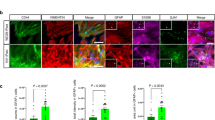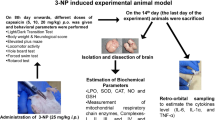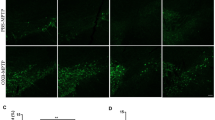Abstract
Ceftriaxone has been shown to attenuate the dopaminergic neuron death and alleviate behavioral disorders in Parkinson’s disease models via upregulation of glutamate transporter-1 (GLT-1) and decreases in extracellular glutamate. However, details of how this neuroprotection occurs are uncertain. We hypothesized that cytoprotection by ceftriaxone in astrocytes exposed to 1-methyl-4-phenylpyridinium (MPP+) involves suppression of the NF-κB/JNK/c-Jun signaling pathway. Here, we observed a protective effect of ceftriaxone in primary astrocytes exposed to MPP+. Ceftriaxone enhanced glutamate uptake and promoted primary astrocyte viability after MPP+ exposure. Ceftriaxone enhances glutamate uptake via upregulation of GLT-1 in the plasma membrane, and alleviates MPP+-induced neurotoxicity via suppression of NF-κB/JNK/c-Jun signaling. Collectively, our data offer evidence that increased expression and function of GLT-1 are involved in the protective mechanism of ceftriaxone in astrocytes exposed to MPP+ in vitro, and we offer insight into the potential therapeutic role of ceftriaxone in treatment of Parkinson’s disease.








Similar content being viewed by others
Abbreviations
- GLT-1:
-
glutamate transporter-1
- MPP+ :
-
1-methyl-4-phenylpyridinium
- GFAP:
-
glial fibrillary acidic protein
- PD:
-
Parkinson’s disease
- PI3K:
-
phosphatidylinositol 3-kinase
- NF-κB:
-
nuclear factor-κB
- CDK4:
-
cyclin-dependent kinase 4
- JNK:
-
c-Jun N-terminal kinases
References
Ankarcrona M, Dypbukt JM, Bonfoco E, Zhivotovsky B, Orrenius S, Lipton SA, Nicotera P (1995) Glutamate-induced neuronal death: a succession of necrosis or apoptosis depending on mitochondrial function. Neuron 15:961–973
Mehta A, Prabhakar M, Kumar P, Deshmukh R, Sharma PL (2013) Excitotoxicity: bridge to various triggers in neurodegenerative disorders. Eur J Pharmacol 698:6–18
Rothstein JD, Dykes-Hoberg M, Pardo CA, Bristol LA, Jin L, Kuncl RW, Bristol LA, Jin L, Kuncl RW, Kanai Y, Hediger MA, Wang Y, Schielke JP, Welty DF (1996) Knockout of glutamate transporters reveals a major role for astroglial transport in excitotoxicity and clearance of glutamate. Neuron 16:675–686
Masliah E, Rockenstein E, Veinbergs I, Mallory M, Hashimoto M, Takeda A, Sagara Y, Sisk A, Mucke L (2000) Dopaminergic loss and inclusion body formation in α-synuclein mice: implications for neurodegenerative disorders. Science 287:1265–1269
Gibb WR, Lees AJ (1988) The relevance of the Lewy body to the pathogenesis of idiopathic Parkinson’s disease. J Neurol Neurosurg Psychiatry 51:745–752
Obeso JA, Olanow CW, Nutt JG (2000) Levodopa motor complications in Parkinson’s disease. Trends Neurosci 23:S2–S7
Blandini F (2010) An update on the potential role of excitotoxicity in the pathogenesis of Parkinson’s disease. Funct Neurol 25:65–71
Morales I, Sabate M, Rodriguez M (2013) Striatal glutamate induces retrograde excitotoxicity and neuronal degeneration of intralaminar thalamic nuclei: their potential relevance for Parkinson’s disease. Eur J Neurosci 38:2172–2182
Had-Aissouni L (2012) Toward a new role for plasma membrane sodium-dependent glutamate transporters of astrocytes: maintenance of antioxidant defenses beyond extracellular glutamate clearance. Amino Acids 42:181–197
Pita-Almenar JD, Zou SW, Colbert CM, Eskin A (2012) Relationship between increase in astrocytic GLT-1 glutamate transport and late-LTP. Learn Mem 19:615–626
Plaitakis A, Shashidharan P (2000) Glutamate transport and metabolism in dopaminergic neurons of substantia nigra: implications for the pathogenesis of Parkinson’s disease. J Neurol 247:II25–II35
Miller BR, Dorner JL, Shou M, Sari Y, Barton SJ, Sengelaub DR, Kennedy RT, Rebec GV (2008) Up-regulation of GLT1 expression increases glutamate uptake and attenuates the Huntington’s disease phenotype in the R6/2 mouse. Neuroscience 153:329–337
Chen KH, Reese EA, Kim HW, Rapoport SI, Rao JS (2011) Disturbed neurotransmitter transporter expression in Alzheimer disease brain. J Alzheimers Dis 26:755–766
Ferrarese C, Tremolizzo L, Rigoldi M, Sala G, Begni B, Brighina L, Ricci G, Albizzati MG, Piolti R, Crosti F, Dalprà L, Frattola L (2001) Decreased platelet glutamate uptake and genetic risk factors in patients with Parkinson’s disease. Neurol Sci 22:65–66
Furuta A, Rothstein JD, Martin LJ (1997) Glutamate transporter protein subtypes are expressed differentially during rat CNS development. J Neurosci 17:8363–8375
Chung EK, Chen LW, Chan YS, Yung KK (2008) Downregulation of glial glutamate transporters after dopamine denervation in the striatum of 6-hydroxydopamine-lesioned rats. J Comp Neurol 511:421–437
Aoyama K, Matsumura N, Watabe M, Nakaki T (2008) Oxidative stress on EAAC1 is involved in MPTP-induced glutathione depletion and motor dysfunction. Eur J Neurosci 27:20–30
Rothstein JD, Patel S, Regan MR, Haenggell C, Huang YH, Bergles DE, Jin L, Dykes Hoberg M, Vidensky S, Chung DS, Toan SV, Bruijn LI, Su ZZ, Gupta P, Fisher PB (2005) Beta-lactam antibiotics offer neuroprotection by increasing glutamate transporter expression. Nature 433:73–77
Leung TC, Lui CN, Chen LW, Yung WH, Chan YS, Yung KK (2012) Ceftriaxone ameliorates motor deficits and protects dopaminergic neurons in 6-hydroxydopamine-lesioned rats. ACS Chem Neurosci 3:22–30
Chotibut T, Davis RW, Arnold JC, Frenchek Z, Gurwara S, Bondada V, Geddes JW, Salvatore MF (2014) Ceftriaxone increases glutamate uptake and reduces striatal tyrosine hydroxylase loss in 6-OHDA Parkinson’s model. Mol Neurobiol 49:1282–1292
Yang J, Li MX, Luo Y, Chen T, Liu J, Fang P, Jiang B, Hu ZL, Jin Y, Chen JG, Wang F (2013) Chronic ceftriaxone treatment rescues hippocampal memory deficit in AQP4 knockout mice via activation of GLT-1. Neuropharmacology 75C:213–222
Lee SG, Su ZZ, Emdad L, Gupta P, Sarkar D, Borjabad A, Volsky DJ, Fisher PB (2008) Mechanism of ceftriaxone induction of excitatory amino acid transporter-2 expression and glutamate uptake in primary human astrocytes. J Biol Chem 283:13116–13123
Feng D, Wang W, Dong Y, Wu L, Huang J, Ma Y, Zhang Z, Wu S, Gao G, Qin H (2014) Ceftriaxone alleviates early brain injury after subarachnoid hemorrhage by increasing excitatory amino acid transporter 2 expression via the PI3K/Akt/NF-κB signaling pathway. Neuroscience 268C:21–32
Ruzza P, Siligardi G, Hussain R, Marchiani A, Islami M, Bubacco L, Delogu G, Fabbri D, Dettori MA, Sechi M, Pala N, Spissu Y, Migheli R, Serra PA, Sechi G (2013) Ceftriaxone blocks the polymerization of α-synuclein and exerts neuroprotective effects in vitro. ACS Chem Neurosci 5:30–38
Adolph O, Köster S, Räth M, Georgieff M, Weigt HU, Engele J, Senftleben U, Föhr KJ (2007) Rapid increase of glial glutamate uptake via blockade of the protein kinase A pathway. Glia 55:1699–1707
Aoki E, Yano R, Yokoyama H, Kato H, Araki T (2009) Role of nuclear transcription factor kappa B (NF-kappa B) for MPTP (1-methyl-4-phenyl-1,2,3,6-tetrahydropyridine)-induced apoptosis in nigral neurons of mice. Exp Mol Pathol 86:57–64
Yang HJ, Wang L, Xia YY, Chang PN, Feng ZW (2010) NF-kappaB mediates MPP+-induced apoptotic cell death in neuroblastoma cells SH-EP1 through JNK and c-Jun/AP-1. Neurochem Int 56:128–134
Williams CA, Lin Y, Maynard A, Cheng SY (2013) Involvement of NF kappa B in potentiated effect of Mn containing dithiocarbamates on MPP+ induced cell death. Cell Mol Neurobiol 33:815–823
Shang T, Uihlein AV, Van Asten J, Kalyanaraman B, Hillard CJ (2003) 1-methyl-4-phenylpyridinium accumulates in cerebellar granule neurons via organic cation transporter 3. J Neurochem 85:358–367
Przedborski S, Vila M (2003) The 1-methyl-4-phenyl-1,2,3,6- tetrahydropyridine mouse model: a tool to explore the pathogenesis of Parkinson’s disease. Ann N Y Acad Sci 991:189–198
Yao HH, Ding JH, He HR, Hu G (2004) Inhibitory effects of 1-methyl-4-phenylpyridinium on glutamate uptake into cultured C6 glioma cells. Acta Pharmacol Sin 25:855–860
Beller JA, Gurkoff GG, Berman RF, Lyeth BG (2011) Pharmacological enhancement of glutamate transport reduces excitotoxicity in vitro. Restor Neurol Neurosci 29:331–346
Bachetti T, Di Zanni E, Balbi P, Bocca P, Prigione I, Deiana GA, Rezzani A, Ceccherini I, Sechi G (2010) In vitro treatments with ceftriaxone promote elimination of mutant glial fibrillary acidic protein and transcription down-regulation. Exp Cell Res 316:2152–2165
Zhou J, Sutherland ML (2004) Glutamate transporter cluster formation in astrocytic processes regulates glutamate uptake activity. J Neurosci 24:6301–6306
Sheldon AL, González MI, Krizman-Genda EN, Susarla BT, Robinson MB (2008) Ubiqutination mediated internalization and degradation of the astroglial glutamate transporter GLT-1. Neurochem Int 53:296–308
González-González IM, García-Tardón N, Giménez C, Zafra F (2008) PKC-dependent endocytosis of the GLT1 glutamate transporter depends on ubiquitylation of lysines located in a C-terminal cluster. Glia 56:963–974
Susarla BT, Robinson MB (2008) Internalization and degradation of the glutamate transporter GLT-1 in response to phorbol ester. Neurochem Int 52:709–722
Martínez-Villarreal J, García Tardón N, Ibáñez I, Giménez C, Zafra F (2012) Cell surface turnover of the glutamate transporter GLT-1 is mediated by ubiquitination/deubiquitination. Glia 60:1356–1365
Tolosa L, Caraballo-Miralles V, Olmos G, Lladó J (2011) TNF-α potentiates glutamate-induced spinal cord motoneuron death via NF-κB. Mol Cell Neurosci 46:176–186
Rodriguez-Kern A, Gegelashvili M, Schousboe A, Zhang J, Sung L, Gegelashvili G (2003) Beta-amyloid and brain-derived neurotrophic factor, BDNF, up-regulate the expression of glutamate transporter GLT-1/EAAT2 via different signaling pathways utilizing transcription factor NF-kappaB. Neurochem Int 43:363–370
Zelenaia O, Schlag BD, Gochenauer GE, Ganel R, Song W, Beesley JS, Grinspan JB, Rothstein JD, Robinson MB (2000) Epidermal growth factor receptor agonists increase expression of glutamate transporter GLT-1 in astrocytes through pathways dependent on phosphatidylinositol 3-kinase and transcription factor NF-kappaB. Mol Pharmacol 57:667–678
Sitcheran R, Gupta P, Fisher PB, Baldwin AS (2005) Positive and negative regulation of EAAT2 by NF-kappaB: a role for N-myc in TNFalpha-controlled repression. EMBO J 24:510–520
Henkel T, Machleidt T, Alkalay I, Krönke M, Ben-Neriah Y, Baeuerle PA (1993) Rapid proteolysis of I kappa B-alpha is necessary for activation of transcription factor NF-kappa B. Nature 365:182–185
Alvira D, Tajes M, Verdaguer E, de Arriba SG, Allgaier C, Matute C, Trullas R, Jiménez A, Pallàs M, Camins A (2007) Inhibition of cyclin-dependent kinases is neuroprotective in 1-methyl-4-phenylpyridinium-induced apoptosis in neurons. Neuroscience 146:350–365
Pizarro JG, Junyent F, Verdaguer E, Jordan J, Beas-Zarate C, Pallàs M, Camins A, Folch J (2010) Effects of MPP+ on the molecular pathways involved in cell cycle control in B65 neuroblastoma cells. Pharmacol Res 61:391–399
Black AR, Black JD (2013) Protein kinase C signaling and cell cycle regulation. Front Immunol 3:423
Acknowledgments
This work was supported by grants from the Science and Technology Planning Project of Guangdong Province (2012B050200003) and the Science and Technology Planning Project of Guangzhou (2013J4500018).
Conflict of Interests
The authors declare that they have no competing interests.
Author information
Authors and Affiliations
Corresponding author
Rights and permissions
About this article
Cite this article
Zhang, Y., Zhang, X. & Qu, S. Ceftriaxone Protects Astrocytes from MPP+ via Suppression of NF-κB/JNK/c-Jun Signaling. Mol Neurobiol 52, 78–92 (2015). https://doi.org/10.1007/s12035-014-8845-z
Received:
Accepted:
Published:
Issue Date:
DOI: https://doi.org/10.1007/s12035-014-8845-z




